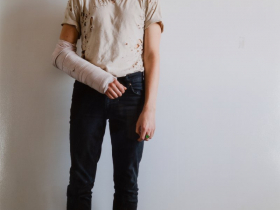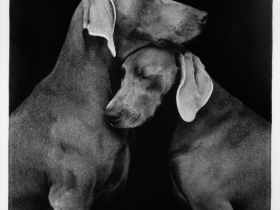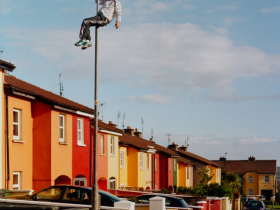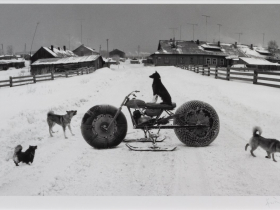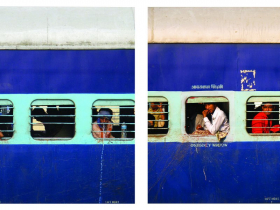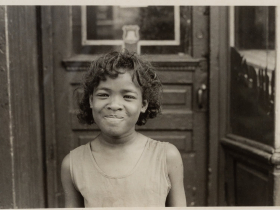100 Years Of Memorable Photography
Warehouse Art Museum exhibit offers a century of international photography. It’s a fun show.
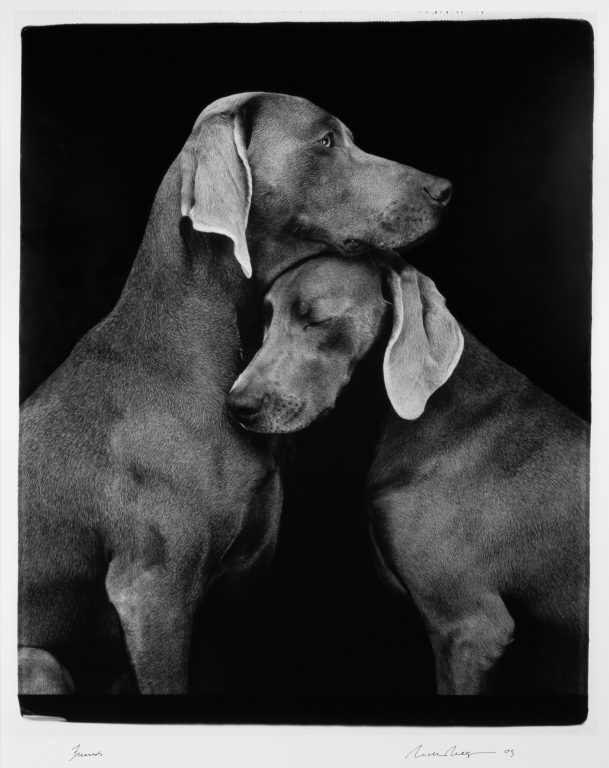
William Wegman – Friends, 2009. Inkjet. From the Warehouse Art Museum Collection. Photographed by Avery Pelekoudas.
One of the first works you encounter upon entering the exhibit “Pause/Connect” at the Warehouse Art Museum is a large black-and-white image of two dogs snuggling each other by photographer William Wegman. Wegman’s photos of his beloved Weimaraners are iconic and have been seen everywhere, from international exhibits to the “Sesame Street” show. They can be very funny, but this one, “Friends,” from 2009, is gentle and rather poignant.
It fits nicely into this exhibit of photographs from the collection of Jan Serr and John Shannon: the works are typically understated, often humorous and with a warmth and humanity that can tug at the heart. The show includes more than 80 of the 308 photographic works in the collection of Serr and Shannon, chosen by photo curator Lisa Hostetler and with texts by her. Hostetler was formerly at the Milwaukee Art Museum before leaving for the George Eastman Museum in Rochester, and her choices make for a very strong show.
While most of the works are figurative/narrative, the works cover a variety of photographic processes and techniques reflecting the practice and styles of their time. The time period is the last century or so, with the earliest work from 1910, a Lewis Hine image of a delivery boy. The show is not organized chronologically, but in four groups ”according to the nature of the photographic relationships they suggest,” as Hostetler writes in the show’s catalog. The themes used to divide the exhibit’s works aren’t all that useful, and you don’t need to know how an image was created or printed to appreciate the end result, which in most cases transcends the process. You can take in the show however you want and you won’t be sorry: there is a lot of great work on display.
Some of the best known works, besides the Wegman photograph, include those by Margaret Bourke-White, “Margaret Bourke-White Working Atop the Chrysler Building, New York, NY” (1934); Gordon Parks’ Self-Portrait (1941); Bruce Davidson’s “Brooklyn Gang” (1959); Lee Friedlander’s “Seattle” (1967); Nan Goldin’s “Self-Portrait in Blue Dress, New York City” (1985); and Sally Mann’s “Jessie Bites” (1985).
Parks, the celebrated African-American photographer, is represented by two works, including the self-portrait in which he is pointing the camera lens at a mirror — kind of a selfie, but infused with a serious intensity which is evident in many of his images. The second photograph, “Music-That Lordly Power” (1993), has an interior referencing 19th Century painter James Abbot McNeil Whistler. A young man is playing a cello as a woman leans against his shoulder tenderly listening to the music. The man’s bare feet are at odds with the formal, old-fashioned room in which they sit, but lend a modern air of unpretentiousness to the image.
There are six photographs by the optician from Normal, Illinois, Ralph Eugene Meatyard. Described as “Gothic Surrealism,” his photographs in luscious black and white are intriguing and mysterious but not creepy. There is a playfulness and a great sense of balance to his innocent seeming portrayals of children playing and small-town country life.
I was struck by this sense of mystery in many of the exhibit’s works. Many are also of children and teenagers, including the poignant image of a child imitating her mother applying make-up in Carrie Mae Weems photo, “Untitled,” from 1990. “Jordan Up a Pole,” a 2010 photograph by Doug Dubois, captures a teen boy balanced high up on a lamp post in Cobh, Ireland, above a row of houses that all look the same, at once conveying his jubilant freedom and the confined life and future he may face. And Davidson’s “Brooklyn Gang,” from 1959, captures the vulnerability of teens acting cool: A girl reflected in a cigarette machine is fixing her hair while her boyfriend rolls up his shirt sleeve to tuck in a pack of smokes.
A quite different image of children is Fan Ho’s “School Is Over,” from 1963, a vertical composition in which the students become the calligraphic characters to lead the eye in a stacked perspective moving up the frame.
Several photos shot from or toward windows and doors are quite striking. Friedlander’s “Seattle” is shot from the open door of a passing car and captures three ages of women: a young student, a career woman and a young mother all on the same street. The viewer can imagine Friedlander seeing this as he drove by and just saying “pull over” and snapping the photo.
Marc Riboud’s “Liv Li Chang”(1965), is shot through the delicate windows of a train and looking into an Asian neighborhood (in China?) and the six windows each frame a different set of figures in their own vignette. “Agra Train Station” by Jan Serr, captures the brilliant teal blue of a passing train, as passengers stare out of windows, including one man rinsing out his mouth and caught in mid-spit, with the delicate stream breaking the horizontality of the photo.
Other memorable photos: Harry Callahan’s “Morocco” (1981) features a bubble-gum pink industrial building with sky blue doors and windows pierced by two figures walking across the frame, their sharp black shadows making you feel the heat and bright sun. Nirmal Raja’s “Thread in Open Water” (2019) is a digital video and fabric piece, a kind of meditation on water and waves combined with a hand stitching the image together. And two sand animations by Adam Stoner, which require the meticulous and time consuming moving of sand on a lightbox and photographing each frame, are remarkable. The images are reminiscent of the early drawings of Georges Seurat.
One piece was memorable in a less lovely way. The Carla Gannis video, “Virtues and Vices” (2023), is a 19-minute video installation that examines AI and ChatGPT and was quite intense, a sensory overload that was difficult to watch. I can’t say I liked it, but I am glad I saw it!
The list of top photographers in this show is long and it’s an impressive collection of works, showing the discerning eye of Serr and Shannon. The images are supported by excellent text panels and a catalog as well as audio guides. The show runs through through Nov. 10 at the Warehouse Art Museum, 1635 W. St. Paul Ave.
Gallery
If you think stories like this are important, become a member of Urban Milwaukee and help support real, independent journalism. Plus you get some cool added benefits.
Art
-
Winning Artists Works on Display
 May 30th, 2024 by Annie Raab
May 30th, 2024 by Annie Raab
-
5 Huge Rainbow Arcs Coming To Downtown
 Apr 29th, 2024 by Jeramey Jannene
Apr 29th, 2024 by Jeramey Jannene
-
Exhibit Tells Story of Vietnam War Resistors in the Military
 Mar 29th, 2024 by Bill Christofferson
Mar 29th, 2024 by Bill Christofferson

